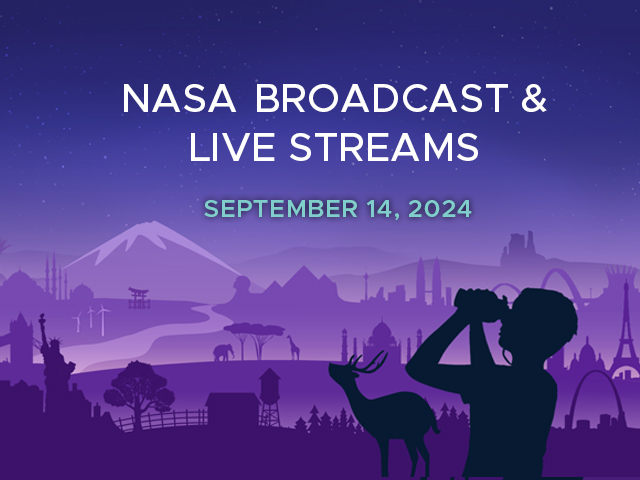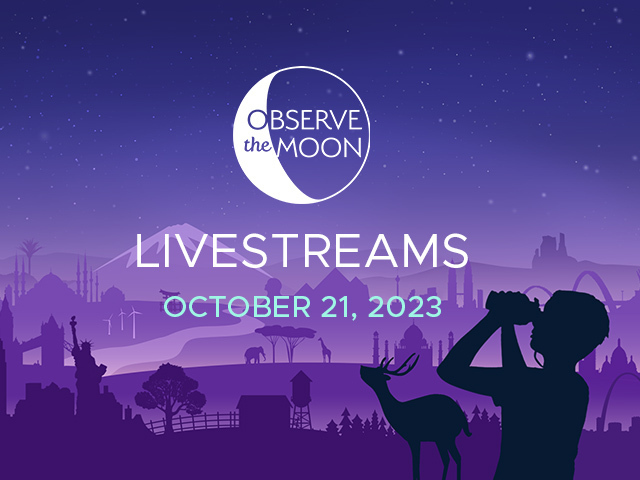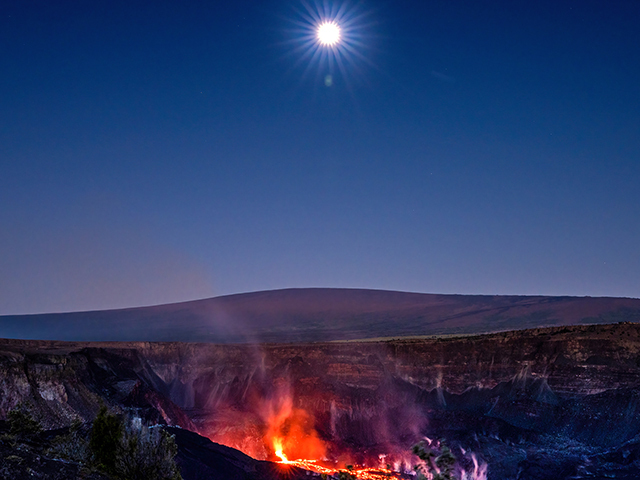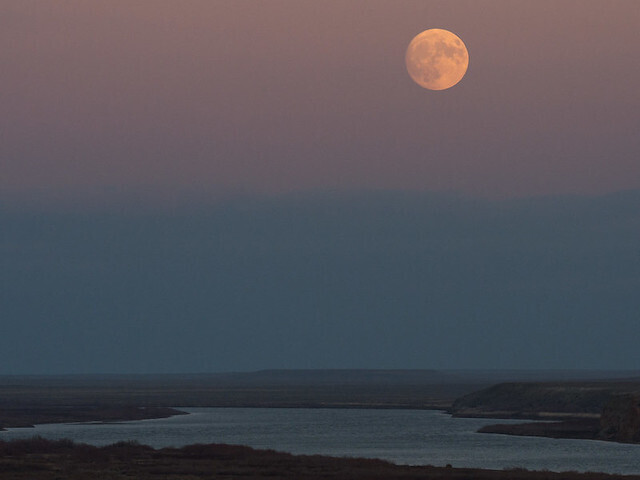News | August 13, 2016
The Next Full Moon is the Sturgeon Moon
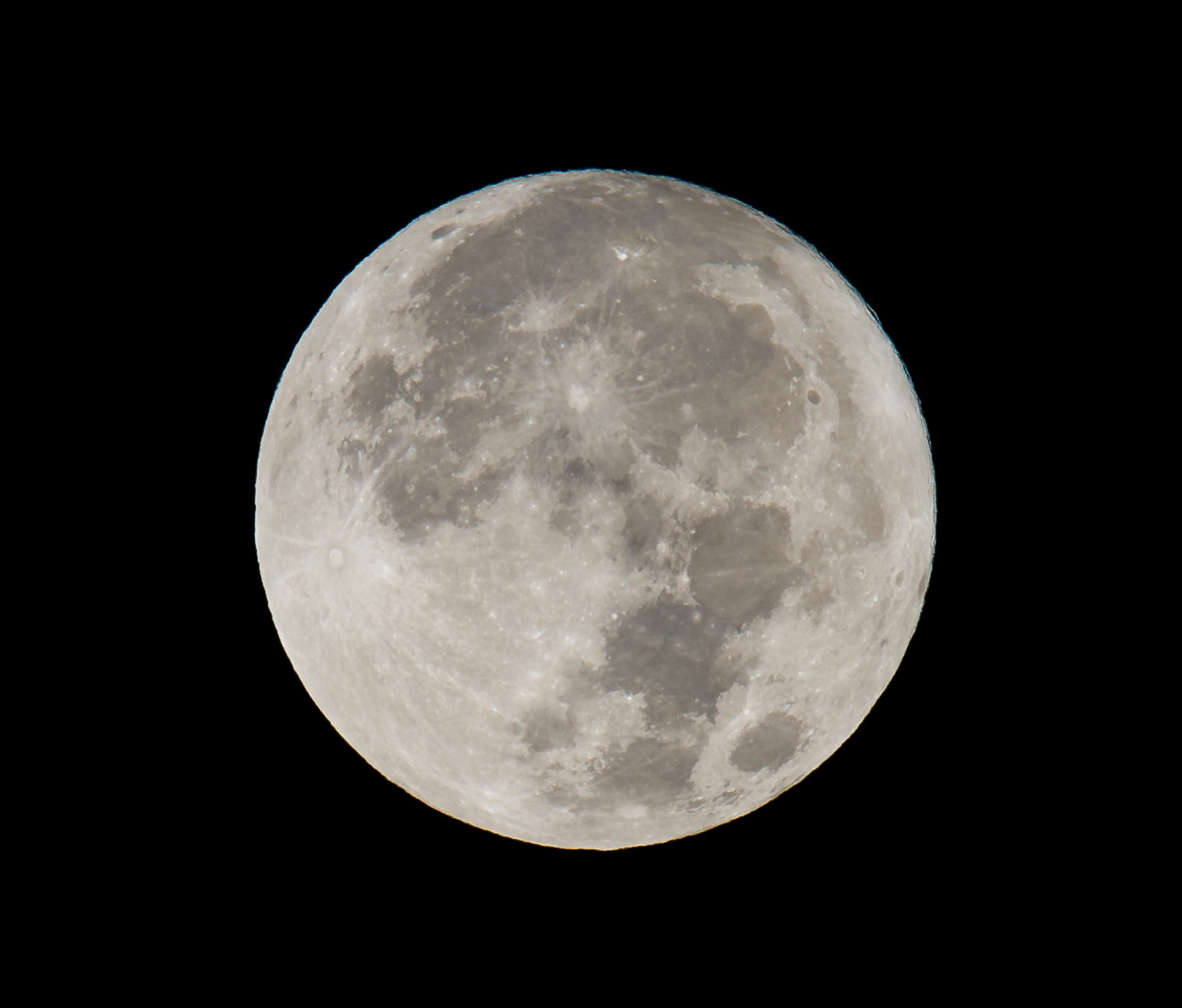
Credit: (NASA/Aubrey Gemignani)
The next full Moon will be on Thursday morning, August 18, 2016, appearing "opposite" the Sun (in Earth-based longitude) at 5:27 AM EDT. The Moon will appear full for about three days around this time, from Tuesday evening through Friday morning.
The Maine Farmer's Almanac first published Indian names for the full Moons in the 1930's. According to this almanac, the Native Americans tribes of what is now the northern and eastern United States named the second full Moon of the summer season the Sturgeon Moon, as sturgeon, a large fish of the Great Lakes and other major bodies of water, were more readily caught at this time of year. A few tribes called this the Red Moon because the rising Moon appears reddish through the sultry hazes of summer (a name related to the European "Rose Moon" for the full Moon nearest the summer solstice). It was also called the Green Corn Moon or the Grain Moon.
In lunisolar calendars the months change with the new Moon and full Moons fall in the middle of the lunar month. This full Moon is the middle of the seventh month of the Chinese calendar and Av in the Hebrew calendar. In the Islamic calendar the months start with the first sighting of the waxing crescent Moon a few days after the New Moon. This full Moon is near the middle of Dhu al-Qi'dah, the eleventh month in the Islamic calendar, one of the four sacred months in Islam during which warfare is prohibited, hence the name "Master of Truce."
As usual, the wearing of suitably celebratory celestial attire is encouraged in honor of the full Moon. Perhaps you should consider reading some Theodore Sturgeon in honor of this full Moon, and please, no fighting...
As for other celestial sights between now and the full Moon after next:
As Summer continues, the daily periods of sunlight continue to shorten. For the Washington, DC area, on the day of the August full Moon, morning twilight will begin at 5:23 AM, sunrise will be at 6:25 AM, the Sun will reach a maximum altitude of 63.9 degrees at 1:12 PM, sunset will be at 7:58 PM, and evening twilight will end at 9:00 PM EDT. By the day of the September full Moon, morning twilight will begin at 5:53 AM, sunrise will be at 6:51 AM, the Sun will reach a maximum altitude of 53.4 degrees at 1:03 PM, sunset will be at 7:14 PM, and evening twilight will end at 8:12 PM EDT.
The Perseids are usually one of the best meteor showers of the year. The Perseids should continue to late August, having peaked the morning of Friday, August 12, 2016. The Perseid meteors are caused by dust from the comet 109P/Swift-Tuttle that enters our atmosphere at 58 kilometers per second (130,000 miles per hour). The best time to look for meteors is when the Moon is not up, it is after midnight, but before the sky starts to lighten with dawn. And you need clear skies, a clear view of the sky, and to be far from interfering city lights.
On the evening of the August full Moon, about 30 minutes after sunset, all of the visible planets and the Moon will be in the sky at the same time. For the Washington, DC area, 30 minutes after sunset will be at 8:28 PM EDT, when the bright planets Jupiter, Mercury, and Venus will appear clustered very low on the western horizon. The bright planets Mars and Saturn, along with the bright star Antares, will appear in the south. The Moon will have just risen in the east-southeast. For the DC area, both Mercury and Venus will set a 8:54 PM, evening twilight will end at 9:00 PM, and Jupiter will set at 9:14 PM. Also in the evenings, the Summer Triangle formed by the three bright stars Altair, Deneb, and Vega, will appear high in the east, with Vega appearing nearly overhead.
Jupiter and Venus will appear to move closer together each evening until Saturday, August 27, 2016, when they will appear nearly on top of each other, just 0.04 degrees apart, with Venus above Jupiter. It is unusual to see two bright planets appear so close to each other. Adding to the show, Mercury will appear about 3.5 degrees to the lower left of Jupiter. To see them, you will need a very clear view of the western horizon, for they will be close to setting. For the Washington, DC area, 30 minutes after sunset will be at 8:15 PM, Mercury will set at 8:24 PM, Jupiter and Venus will set around 8:43 PM, and evening twilight will end at 8:46 PM.
By the evening of the September full Moon, Mercury will have left the evening sky and Jupiter will set just 21 minutes after sunset, making Jupiter hard to see in the evening glow. Venus will remain visible as the evening star, with the bright star Spica appearing to the left of Venus. As evening twilight ends, the planets Mars and Saturn, along with the bright star Antares, will appear in the southwest, and the bright star Vega, part of the summer triangle, will appear directly overhead. For the Washington, DC area, evening twilight will end at 8:12 PM and Venus will set at 8:21 PM EDT.
In the mornings from the August full Moon to the September full Moon, as morning twilight begins, the bright stars of the local arm of the Milky Way galaxy will be visible across the sky, having emerged from the glow of dawn in late July.
Tuesday, August 16, 2016, is when Mercury is at its greatest eastern elongation, appearing 27.4 degrees to the east of the Sun as seen from Earth.
As mentioned above, the next full Moon will be on Thursday, August 18, 2016, at 5:27 AM EDT.
On Sunday, August 21, 2016, at 9:20 PM EDT, the Moon will be at perigee, its closest to the Earth for this orbit.
Wednesday evening, August 24th, is when the planets Saturn and Mars, along with the bright star Antares, will appear at their closest to each other. For the Washington, DC area, as evening twilight ends at 8:50 PM EDT, Saturn will appear highest in the south-southwest (28 degrees above the horizon), with Mars appearing 4 degrees below Saturn and Antares appearing less than 2 degrees below Mars.
On Wednesday, August 24, 2016, the waning Moon will appear half-full as it reaches its last quarter at 11:41 PM EDT.
Early Thursday morning, August 25, 2016, the bright star Aldebaran will appear near the nearly half waning Moon. For the Washington, DC area, the half-lit Moon will rise just after midnight Thursday morning, at 12:08 AM EDT, with Aldebaran rising at 12:30 AM, appearing about 5.5 degrees to the lower left of the Moon. The Moon and Aldebaran will appear to move closer together until Aldebaran is lost in the glow of dawn (morning twilight will begin at 5:30 AM). By the time Aldebaran and Moon rise again around 1 AM Friday morning, they will appear again about 5.5 degrees apart, this time with Aldebaran to the upper right, and will continue to appear to separate.
Even though they are not visible usually, I include in these Moon missives information about Near Earth Objects (mostly asteroids) that pass the Earth within about 15 lunar distances, because I find it interesting that we have discovered so many. On Thursday morning, August 25, 2016 at about 7:23 AM EDT (2016-Aug-25 11:23 UTC with 5 minutes uncertainty), Near Earth Object (2016 PS26), between 20 and 45 meters (66 to 148 feet) in diameter, will pass the Earth at between 13.4 and 14.2 lunar distances (nominally 13.8), traveling at 11.65 kilometers per second (26,061 miles per hour).
On Saturday evening, August 27, 2016, shortly after sunset when dusk remains in the sky, the planets Jupiter and Venus will appear nearly on top of each other, less than a tenth of a degree apart, with Venus above Jupiter. Mercury will appear about 3.5 degrees to the lower left of Jupiter. To see them, you will need a very clear view of the western horizon, for they will be close to setting. It is unusual to see two bright planets appear so close to each other. For the Washington, DC area, 30 minutes after sunset will be at 8:15 PM, Mercury will set at 8:24 PM, Jupiter and Venus will set around 8:43 PM, and evening twilight will end at 8:46 PM.
On Monday afternoon, August 29, 2016, at around 3:20 PM EDT (2016-Aug-29 19:20 UTC with 22 minutes uncertainty), Near Earth Object (2016 PA40), between 35 and 78 meters (115 to 257 feet) in diameter, will pass the Earth at between 14.3 and 14.8 lunar distances (nominally 14.6), traveling at 9.24 kilometers per second (20,663 miles per hour).
Thursday, September 1, 2016, at 5:03 AM EDT, will be the new Moon. Most months, when the Moon passes between the Earth and the Sun, it is not be visible from the Earth. This time, for most of Africa, the Moon will be visible, because it will be partially blocking the Sun. For a narrow stripe from Gabon to Madagascar, the Moon will appear to pass directly in front of the Sun, but will be too far away to completely block all sunlight, causing what is called an Annular Solar Eclipse.
On Friday, September 2, 2016, shortly after sunset, you might be able to catch a glimpse of the thin, waxing, crescent Moon with Jupiter appearing just about one lunar diameter to the right. You would need a very clear view of the western horizon, and would probably need to use binoculars or a telescope (remember to wait until after sunset before pointing binoculars or a telescope anywhere near the Sun). For the Washington, DC area, Sunset will be at 7:36 PM EDT, Mercury will set 22 minutes later at 7:58 PM, Jupiter and the Moon will set at 8:23 PM, and Venus will set just around the time evening twilight ends, at 8:36 PM.
Saturday evening, September 3, 2016, the Moon will appear to the upper left of Venus. For the Washington, DC area, evening twilight will end at 8:34 PM, Venus will set 2 minutes later, and the Moon will set at 8:54 PM EDT.
On Sunday evening, September 4, 2016, the bright star Spica will appear to the lower left of the thin, waxing, crescent Moon.
On Monday morning, September 5, 2016, at around 10:04 AM EDT (2016-Sep-05 14:04 UTC with 45 minutes uncertainty), Near Earth Object (2016 PD2), between 29 and 65 meters (96 to 214 feet) in diameter, will pass the Earth at between 18.5 and 19.0 lunar distances (nominally 18.7), traveling at 6.70 kilometers per second (14,987 miles per hour).
On Monday afternoon, September 5, 2016, at 3:25 PM EDT (2016-Sep-05 19:25 UTC), Near Earth Object (2009 ES), between 211 and 472 meters (693 to 1549 feet) in diameter, will pass the Earth at 18.8 lunar distances, traveling at 18.06 kilometers per second (40,409 miles per hour).
Sometime around Tuesday morning, September 6, 2016, at 2:00 AM EDT (2016-Sep-06 06:00 UTC with 6 hours 41 minutes uncertainty), Near Earth Object (2016 PR39), between 37 and 82 meters (120 to 269 feet) in diameter, will pass the Earth at between 17.9 and 19.2 lunar distances (nominally 18.5), traveling at 11.13 kilometers per second (24,887 miles per hour).
On Tuesday, September 6, 2016, at 2:44 PM EDT, the Moon will be at apogee, its farthest from the Earth for this orbit.
On Thursday evening, September 8, 2016, the bright planet Saturn will appear below the waxing, nearly half-full Moon. Mars and the bright star Antares will also appear nearby. For the Washington, DC area, evening twilight will end at 8:25 PM EDT, Antares will set at 10:53 PM, Saturn will set at 11:23 PM, Mars will set at 11:36 PM, and the Moon will set at 11:45 PM.
On Friday, September 9, 2016, the Moon will appear half-full as it reaches its first quarter at 7:49 AM EDT.
On Saturday morning, September 10, 2016, at 4:25 AM EDT (2016-Sep-10 08:25 UTC), Near Earth Object (2015 KE), between 14 and 31 meters (46 to 102 feet) in diameter, will pass the Earth at 14.9 lunar distances, traveling at 2.16 kilometers per second (4,833 miles per hour).
On Monday afternoon, September 12, 2016, at 4:55 PM EDT (2016-Sep-12 20:55 UTC), Near Earth Object (2016 LX48), between 367 and 820 meters (1204 to 2692 feet) in diameter, will pass the Earth at 17.7 lunar distances, traveling at 10.77 kilometers per second (24,093 miles per hour).
Monday, September 12, 2016, at 7:38 PM EDT, is the Inferior Conjunction of Mercury, when Mercury passes between the Earth and the Sun, moving from the evening sky into the morning sky.
The full Moon after next will be on Friday, September 16, 2016, at 3:05 PM EDT. The Moon will enter the partial shadow of the Earth at around 12:55 PM and exit the partial shadow at 4:54 PM EDT. If you could see this eclipse, the slight and subtle dimming of the Moon due to the Earth's partial shadow would be difficult to see, and this occurs at a time when the Moon is not visible from nearly all of the Americas.The next full Moon will be on Thursday morning, August 18, 2016, appearing "opposite" the Sun.


